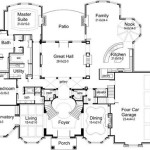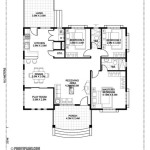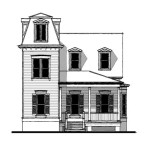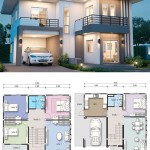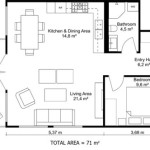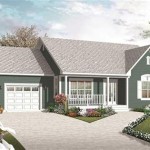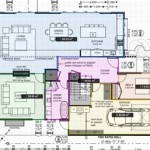L-Shaped House Plans with 3 Rooms: Design Considerations and Benefits
L-shaped house plans represent a versatile architectural style, adaptable to various lot configurations and offering unique spatial organization. When designed with three rooms, these plans present focused functionality, optimal for smaller families, single occupants, or those seeking a compact living solution. The distinctive L-shape allows for a separation of living zones, enhanced access to natural light, and potential for private outdoor spaces.
The configuration of a 3-room L-shaped house can be tailored to specific needs and lifestyles. Generally, the three rooms encompass a living area, a bedroom, and a kitchen/dining combination. However, variations exist, substituting a second bedroom or a dedicated office space based on the homeowner's requirements. The crucial aspect lies in maximizing efficiency within the limited square footage while leveraging the advantages of the L-shaped structure.
Key Point 1: Spatial Separation and Zoning
One of the primary benefits of the L-shaped design, even in a 3-room configuration, is the inherent separation of space. The two "wings" of the L naturally lend themselves to distinct uses. One wing often houses the living area, providing a space for relaxation and entertainment. The other wing typically accommodates the private zones, such as the bedroom. This physical separation minimizes noise transfer and creates a more peaceful environment for both active and restful activities.
Within this zoning, strategic placement of the kitchen and dining area becomes crucial. Often, the kitchen is situated at the intersection of the two wings, serving as a central hub connecting the living and private spaces. This design promotes accessibility and fluid movement throughout the house. The dining area can then extend from the kitchen, either as a distinct space or integrated within the living area, depending on the desired level of openness.
Furthermore, this spatial separation can be enhanced with interior design elements. Variations in flooring materials, wall colors, and lighting schemes can further delineate the different zones within the house. For example, the living area might feature warmer tones and softer textures, while the bedroom might prioritize cooler colors and blackout curtains for optimal sleep. This intentional design approach enhances the functionality and aesthetic appeal of the 3-room L-shaped house.
Consideration should also be given to the orientation of the L-shape on the building lot. Maximizing natural light penetration is a key objective, and the alignment of the wings can significantly impact the amount of sunlight each room receives. Careful planning can ensure that the living area is bathed in natural light during the day, while the bedroom benefits from morning sun exposure. This strategic orientation contributes to energy efficiency and creates a more comfortable living environment.
Key Point 2: Maximizing Natural Light and Ventilation
The L-shaped design inherently promotes natural light and ventilation. The two exterior walls of each wing provide ample opportunities for window placement, allowing sunlight to penetrate deep into the interior spaces. This abundant natural light reduces the reliance on artificial lighting, contributing to energy savings and creating a brighter, more inviting atmosphere.
The corner created by the L-shape also acts as a natural wind tunnel, enhancing cross-ventilation. By strategically placing windows on opposing walls, airflow can be optimized, promoting natural cooling and reducing the need for air conditioning. This is particularly beneficial in warmer climates, where natural ventilation can significantly improve thermal comfort and reduce energy consumption.
To further maximize natural light, consider incorporating large windows or sliding glass doors in the living area. These features not only allow for ample sunlight but also provide direct access to the outdoors, blurring the lines between the interior and exterior spaces. Skylights can also be strategically placed in areas where natural light is limited, such as hallways or bathrooms. Careful window selection, considering factors like insulation and solar heat gain, is crucial for optimizing energy efficiency.
The orientation of the house on the lot plays a significant role in maximizing natural light. In the northern hemisphere, a south-facing orientation is generally preferred, as it allows for maximum sunlight exposure throughout the day. However, it's essential to consider shading strategies to prevent overheating during the summer months. Overhangs, awnings, or strategically planted trees can provide shade and reduce solar heat gain, ensuring a comfortable and energy-efficient living environment. In any climate, understanding local wind patterns and sun angles is key to creating a home that is passively heated and cooled by nature.
Key Point 3: Outdoor Space Integration and Privacy
The L-shaped configuration creates a natural outdoor space, often referred to as a courtyard. This courtyard can be designed as a private patio, garden, or entertainment area, offering a secluded retreat from the outside world. The walls of the house provide a sense of enclosure, creating a more intimate and protected environment.
The connection between the interior and exterior spaces is crucial in maximizing the enjoyment of the courtyard. Sliding glass doors or French doors can seamlessly connect the living area to the outdoor space, blurring the lines between inside and out. This connection allows for easy access to the courtyard and creates a sense of spaciousness, even in a smaller house.
The design of the courtyard should complement the overall aesthetic of the house. Landscaping, paving materials, and outdoor furniture should be carefully selected to create a cohesive and harmonious space. Consider incorporating elements such as a water feature, fire pit, or outdoor kitchen to enhance the functionality and appeal of the courtyard. The courtyard can act as an extension of the living space, perfect for dining, relaxing, or entertaining guests.
Furthermore, the courtyard can provide privacy from neighbors or street traffic. The walls of the house act as a barrier, creating a secluded and protected outdoor space. Strategic landscaping, such as hedges or trees, can further enhance privacy and create a more secluded environment. The orientation of the house on the lot can also be adjusted to maximize privacy, ensuring that the courtyard is shielded from unwanted views.
Beyond privacy, the courtyard can be designed to serve practical purposes. Consider incorporating a small garden for growing vegetables or herbs, or creating a storage area for outdoor equipment. The courtyard can also serve as a safe and secure play area for children or pets. The versatility of the courtyard makes it a valuable asset to the 3-room L-shaped house, providing a functional and enjoyable outdoor space for a variety of activities.
In summary, L-shaped house plans for a 3-room home offer a blend of spatial efficiency and functional zoning. The design encourages natural light and ventilation, while the L-shape fosters a private outdoor space. Considerations for orientation, window placement, and material selection are paramount to achieving an optimal living environment.

L Shaped House Design 3 Bedroom Floor Plan Images Nethouseplans

Elegant L Shaped 3 Bedroom House Plans New Home Design

House Plan Ch303

L Shaped House Design 3 Bedroom Floor Plan Images Nethouseplans

L Shaped House Plans With 3 Bedrooms Houseplans Blog Com

Td 41201 1 3 Single Story L Shaped Scandinavian House Plan

L Shaped House Plans With 3 Bedrooms Houseplans Blog Com

Best Of L Shaped Ranch House Plans New Home Design

L Shaped House Design 3 Bedroom Floor Plan Images Nethouseplans

Three Bedroom Floor Plan For L Shaped House Framing Ideas
Related Posts

